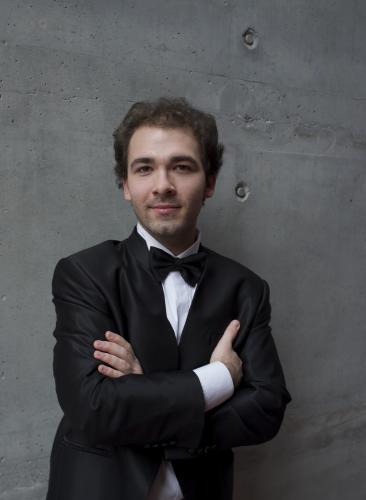The past is prologue for Borowiak’s program of Chopin and Pelosi

Mateusz Borowiak performed music of Chopin and Louis Pelosi Sunday night at Merkin Hall.
On Sunday night, Mateusz Borowiak opened a series of concerts he will be playing this week at Merkin Hall with a performance that was a model of the ideas he has in store for audiences.
Each of the Polish pianist’s three concerts is built through a combination of great Etudes from the piano repertory and, across the three nights, the world premieres of Piano Sonatas Nos. 1–6 by New York composer Louis Pelosi.
This first program had Pelosi’s Sonata No. 4 and Sonata No. 6 sandwiched around the two sets of Etudes by Chopin, Op. 10 and Op. 25. Everything was set in numerical order, i.e. Sonata 4 in B, Etudes Op. 10, then after intermission Etudes, Op. 25, and Sonata No. 6 in (enharmonically) C-sharp/D-flat.
The two centuries, the 19th and the 21st, fit well together. Pelosi’s aesthetic is founded on tonality, specifically counterpoint—the program note stated “Pelosi’s compositions affirm the conviction that the most substantial music speaks a contrapuntal language,” a refreshingly firm and clear declaration of values.
That counterpoint, which in the two Sonatas ranged from basic contrapuntal bass lines to canonic and fugal structures, was clothed in rich chords very much like those of late romanticism, mixed with slicing dissonances that had a 20th-century American sound, like Roy Harris or early Copland.
Against Chopin, the Sonatas could be heard as extended exercises in harmony. Though there were few modulations, there was a constant, active flow of chords and harmonic rhythm, music with a weighty sound but not thick.
Borowiak‘s playing was lyrical, with fluid forward motion and clear, legato articulation. Clearly, Pelosi’s music speaks to the young musician. But Pelosi’s compositional voice is a personal one, not meant for every interpreter.
Sonata No. 4 could be heard as a new-romantic updating of Debussy, with a grammar based on that of the French composer. But the teleologies differed.
Debussy’s piano music was extroverted, showing things to the listener, whether moonlight over water or merely how the notes worked together.
Pelosi’s Sonatas are an inner monologue, impressing the listener with the sensation that the music was deep in thought, though those thoughts were behind an appealing, but impenetrable, barrier. This was the strength as well as the weakness in the pieces; the individual flavor and subtle, stream-of-consciousness surprises, drew the ear, but relying on the vagaries of thought made for a formlessness in both works that left them feeling stretched out over too long a duration.
This even with the contrapuntal foundation.
In terms of sound, the sensibilities between the present and the past musics were related, and Borowiak’s ordering had the rewarding effect of making Pelosi’s Sonata No. 6 sound like it was responding meaningfully to the Op. 25 Etudes.
The Etudes are of course sets of small, concentrated pieces that do what they do then stop. And they are the epitome of Etudes; they cover a broad range of expressions and often are terrifically difficult to play.
Borowiak had no problem with any of the notes. His technique was superb, clear, controlled, and powerful at any speed, and the Op. 10 Etudes do open at speed.
This music is so fine that all it needs is to be played capably, it does most of the work itself. At least it does in the fast Etudes; in the slower ones, the music expects the pianist to respond to what is written in a thoughtful, expressive way.
Chopin’s expression is often called poetic, but Borowiak’s playing had one convinced the music was prose, short stories, to be exact. They were of two different kinds, the fast ones were all plot—getting from one note to the next—while the slow ones were drama, monologues and dialogues of interior voices. Borowiak was excellent in the fast ones, an action star. The slow ones, however, suffered from (to paraphrase Joe Bob Briggs) too much plot getting in the way of the story.
Perhaps Borowiak is an action star, not yet a character actor. He was at home with the sheer challenge of playing the fast Etudes, he seemed exhilarated by their demands. But in the slow ones, like Op. 10, No. 3, he had little to say beyond placing one note after the next, and barely used rubato.
The Op. 25 set started off with a bit more energy and weight than Borowiak had in the first half. Still, they initially had the same gap between fast and slow. The Op. 25 music is more mature than the earlier Etudes, more assured in the form and structure and so freer and more daring. Some of them, like the D-flat major waltz of the “Sixths” etude have a wildness in them that threatens the structure of the music.
Borowiak seemed too skillful to play with it that way. But as the Etudes went along, the pianist gained exciting energy, a thunderhead building up to torrents of rain and lightning, There was a frisson like one feels when the pressure drops and the wind picks up as the pianists gathered more and more power. Rather than wildness, with the allegro con fuoco of the “Octaves” etude, he reached a level of fury that made for thrilling satisfaction.
Mateusz Borowiak plays Pelosi’s Piano Sonatas 5 and 1 and Debussy Douze Etudes 8 p.m. Wednesday, and Pelosi Piano Sonatas 2 and 3 and Rachmaninoff’s Etudes-Tableaux 8 p.m. Sunday. KaufmanMusicCenter/MCH






